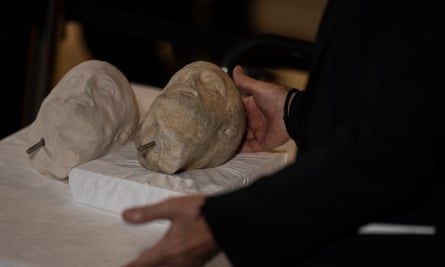The desire of Pope Francis to right a wrong has led to the official return to Greece of three ornately carved fragments that once adorned the Parthenon.
The works, formerly housed in the Vatican Museum, were unveiled in Athens on Friday.
“This act by Pope Francis is of historical significance and has a positive impact on multiple levels,” Greece’s spiritual leader, Archbishop Ieronymos II, told the crowded gallery of the Acropolis Museum where the works will be displayed. “My personal wish is that others will imitate it.”
A much larger collection of works taken from the ancient monument more than 200 years ago is still kept by the British Museum.
The fragments from the Vatican depict the head of a boy, the head of a horse and the head of a bearded man.
Describing the pontiff’s decision as heroic, Greece’s culture minister, Lina Mendoni, said: “Initiatives like these show … how the pieces of the Parthenon can be reunited, healing the wounds caused by barbaric hands so many years ago.”
The museum’s gallery has been specially designed to accommodate the Parthenon sculptures, with plaster copies used in place of those kept in foreign museums.
On Friday, the delicate task of reinstating the relics involved gloved workmen on a mechanised ladder removing the plaster casts. As the head of the third fragment was placed among the sculpted relief panels, some of those gathered wept in disbelief. A moment of silence was then followed by applause.

Francis announced in December that he wanted to donate them to Ieronymos as “a concrete sign of his sincere desire to follow in the ecumenical path of truth”. The head of the Orthodox Church immediately agreed to give them to the Acropolis Museum.
From the outset the Vatican sought to dampen the rhetoric that has raged over the Parthenon sculptures, not least those in the possession of the British Museum.
Its officials insisted that the donation was a religiously inspired move rather than a bilateral state-to-state return that could, or should, be emulated elsewhere. The Vatican Museum holds other priceless artefacts that Indigenous groups would also like to see returned.
Addressing the repatriation ceremony as head of the Vatican’s delegation, Bishop Brian Farrell emphasised that the decision to return the fragments had “matured in the context of [Francis’] fraternal relations with the Orthodox Church”.
But while the gesture underscored the growing “spiritual closeness” between the two Christian institutions, the pope had clearly also chosen sides. Ending his speech Farrell said: “We assure you of our intimate joy at the realisation of your legitimate wish to have the Parthenon fragments at home in their place of origin.”
In recent years Greece has ramped up its campaign for the reunification of the sculptures, spurred partly by “optimistic” signs of a shift in public opinion in Britain.
The two countries have been at odds for decades over statuary removed from the fifth-century BC temple at the behest of Lord Elgin, Britain’s then ambassador to the Ottoman Empire. Athens has long argued that the antiquities, acquired by the British Museum in 1816, were violently detached from the monument with the aid of marble saws. Hopes of the cultural row being resolved in the wake of widespread reports that the British Museum was engaged in secret talks aimed at “a win-win solution” with Greece appeared to be dashed last week when Rishi Sunak rejected any suggestion the treasures were on course to being returned to Athens.
But Greek officials say the Vatican’s move will undoubtedly pile further pressure on London “to do the right thing”.
“The pope has set a global example,” said professor Nikos Stampolidis, the Acropolis Museum’s director, calling the repatriated fragments especially important as they came from three different areas of the Parthenon.
“We are doubly grateful, and honoured, that he has chosen to do this as the head of the Catholic church and not as the leader of the Vatican,” Stampolidis said. “In doing so he has spoken not just for the Holy See but for so many more people.”

